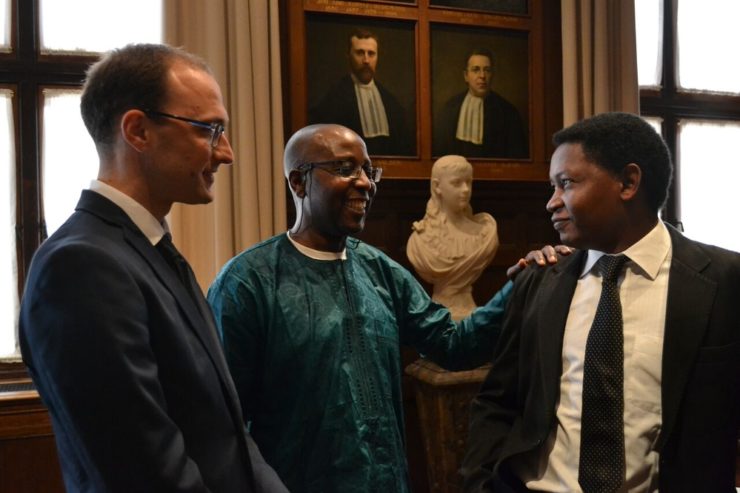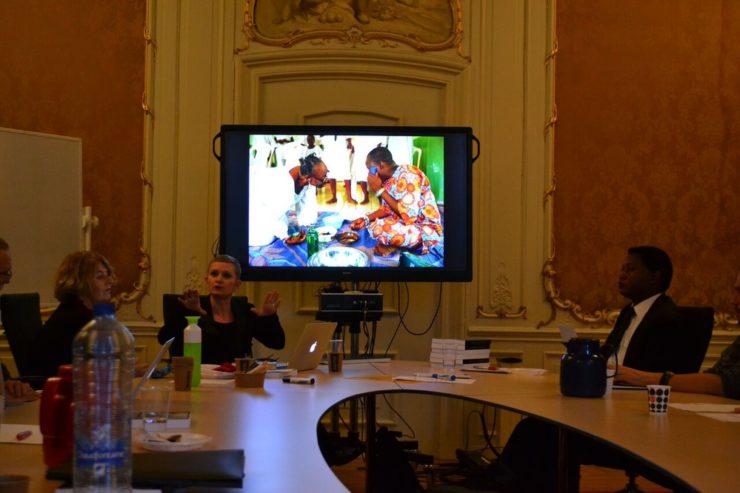On Monday October 30, Dr Murtala Ibrahim defended his PhD thesis entitled Sensational Piety, Practices of Mediation in Christ Embassy and NASFAT. The defense was followed by a symposium that focused on inter- and intra-religious encounters and entanglements of Christians, Muslims and Traditionalists in African urban spaces, that was held at the occasion of the defense. Dr Ibrahim worked on his PhD research as part of the research project Habitus and Habitats, Politics and Aesthetics of Religious World Making that was led by Prof Birgit Meyer and funded by the Alexander Humboldt Foundation.1 The thesis was co-supervised by Prof Hansjörg Dilger (Freie Universität Berlin). Although Dr Ibrahim mostly engaged with his research based in the Berlin Graduate School of Muslim Cultures and Societies and at the Leibniz-Zentrum Moderner Orient in Berlin, the Religious Matters group was lucky to have Murtala as a colleague at Utrecht University as an occasional visitor and during the final stages of his project in the spring of 2017.2
During the defense, Dr Ibrahim eloquently answered questions posed by the committee. The questions focused amongst others on the borrowing of Pentecostal religious forms by NASFAT, the connection of the main argument to themes such as sexuality and intimacy, and its broader implications for the study of religion in religiously diverse settings. Many committee members applauded Dr Ibrahim for his rich ethnographic work on NASFAT and Christ Embassy, through which he demonstrates that engaging with multiple religious traditions through one theoretical framework can yield valuable results. Committee members specifically appreciated the ways in which Dr Ibrahim’s focus on practices of borrowing and copying of religious forms can highlight unexpected commonalities between religious groups. In this way, Ibrahim’s study can provide valuable counterweight to many studies on religion in Nigeria that focus on either conflict or peace between religious groups, which both tend to treat religious traditions as internally integrated belief systems that are separated by clear boundaries and differences.

After the defense, Dr Ibrahim (right) is congratulated by his paranymphs, Dr Daan Beekers (left) and Dr Dauda Abubakar (center)
After the defense, we moved from the Academy Building of Utrecht University to the Department of Philosophy and Religious Studies. In the beautiful Stijlkamer of the department we engaged in an afternoon of presentations and fruitful discussions during the Symposium Inter- and intrareligious encounters and entanglements of Christians, Muslims and Traditionalists in African urban spaces. Presentations were given by Murtala Ibrahim and two committee members, Prof Umar Danfulani from the University of Jos in Nigeria, and Dr Marloes Janson from the School of Oriental and African Studies (SOAS) in London. The presentations were followed by responses from three other colleagues who participated in the defense, namely Prof Rijk van Dijk from the Africa Study Centre at Leiden University, Prof Peter Geschiere from the University of Amsterdam and Prof Hansjörg Dilger from the Freie Universität of Berlin.
In his presentation, Dr Ibrahim compared the usage of new media and technology in the mediation of religious practices in both NASFAT and Christ Embassy. Ibrahim explained how both religious groups use mobile phones to efficiently and conveniently mediate various religious resources, such as sermons, holy scriptures, religious music, and religious text messages. Ibrahim’s presentation also showed how members of the religious groups incorporate such resources in their everyday lives, for example by reading and contemplating religious text messages distributed by NASFAT and Christ Embassy as a daily ritual. Ibrahim specifically demonstrated how the concept of ‘acousmatic listening’, or listening to a sound without seeing the original source can help to explain how NASFAT members experience listening to Quranic recitation through their phones. According to Ibrahim, acousmatic listening directs attention away from the media that channels the recitation (the phone), thus creating a situation of ‘pure mediation’ in which members become fully engulfed in the act of listening. The discussion that followed the presentation focused on how new ways to mediate religious practices also generate new discussions on their proper use (can you take a Qur’an on a mobile phone to a toilet?), and control over the financial benefits of the new media and technologies.
The presentation by Prof Danfulani aimed to investigate the driving forces behind outbreaks of violence between Muslims and Christians in Central Nigeria. Danfulani’s paper intricately showed how violence between Muslims and Christians in Nigeria’s middle belt is driven by factors as diverse as increasing desertification, growing economic inequalities, political competition raised by the return to democracy, the Nigerian constitution which differentiates between settlers and indigenes to determine whether a person qualifies for political offices in particular regions, the proliferation of small arms, and the underdevelopment of the population. Danfulani ended his presentation with a reflection on various ways to search for peace in Central Nigeria. His suggestions primarily focused on improving the living standards in central Nigerian cities such as Jos, highlighting how the precarious economic situation in which many Nigerians find themselves drives interreligious competition and conflict.
Finally, Dr Janson argued in her presentation that rivalry between religious groups is just one aspect that is relevant to the study of religious pluriformity, as boundaries between religious traditions are often porous, while religious identities are fluid. Therefore, Janson focused first on Chrislam, a religious movement that argues that being Christian or Muslim alone is not enough to overcome daily challenges. Chrislam therefore employs both Muslim and Christian religious rituals and practices. Janson argued how its deliverance ideology can explain its popularity among mainly barren women and unemployed youth in the Nigerian megacity of Lagos, who turn to Chrislam to overcome social anxiety and economic hardship. With reference to the work of Talal Asad, Janson thus argued that Chrislamists focus much more on the performative power of religious practice than dedication to a particular religious truth. After discussing Chrislam, Janson moved on to discuss another religious movement, namely Ijo Orumila, that combines forms and practices of Christianity and Yoruba religion. Janson proposed to use the concept of ‘assemblage’ that she derived from the work of Deleuze, Guattari, and Collier and Ong to unlock analytical space to think about the ways in which open systems interact with each other within movements such as Chrislam and Ijo Orumila to create ‘oneness out of original pluralism’, or how they ‘preserve difference through fusion’. In order to productively map out such an assemblage in the religious field, Janson referred to the work of Benjamin Soares and stressed the importance of overcoming institutional boundaries within academia that often give rise to the propensity to study one religion or the interaction between one religion with another, rather than three or more religious groups within one conceptual framework.

Dr Marloes Janson gives her presentation in the Stijlkamer during the symposium
After the presentations, Prof Dilger was the first to provide an elaborate response. According to Dilger, all the presentations clearly showed how interreligious encounters are entangled with a wide range of broader developments. This led him to raise the question how much focus we need on religion in order to understand religion. He argued that although a focus on multiple religious groups within one conceptual framework is fruitful, we could broaden our scope even further to include interaction with the wider environment, such as technology, political economies, social developments, etc., to make our studies even more complex.
Prof Van Dijk subsequently identified three common themes that cut across all three presentations. Based on the presentations, Van Dijk firstly observed a paradigmatic turn within the study of religion, raising the question from which kind of perspective we deal with religious matters, and what exactly the problem is that we aim to explain. The second observation focused on what he called ‘the distributed individual’. Through this concept, Van Dijk aimed to highlight how contrary to Charles Taylor’s idea of a ‘buffered self’, in the digital world the self is shattered as the self becomes part of other peoples’ intimate lives and emotions through technologies such as mobile phones. Van Dijk also argued that such a distributed self resonates with African experiences of spirit possession. Lastly, Van Dijk asked about the position of the sublime and the sceptic in the presentations, asking how certain religious forms may be resisted and questioned by sceptics or non-believers.
Finally, Prof Peter Geschiere’s comments mainly focused on Janson’s use of the concept of assemblage. Geschiere compared the presentation of Janson to his recent observations on Candomblé in Brazil, where instead of treating religious traditions as open systems, people seem to focus much more on what Mattijs van de Port calls ‘politics of authentification’. Geschiere asked how the concept of assemblage can take into account such forces of purity that aim to keep certain religious traditions free from influences of other traditions. Responding to the remarks of Geschiere, Birgit Meyer proposed to conceptualize power as the ability to frame and canalize possibilities into certain folds, thus limiting the forms that religious movements can take.
The defense, the presentations and the lively discussions that followed all demonstrated how the excellent work of Dr Ibrahim contributes and relates to current discussions within the study of religion. We at the department of philosophy and religious studies at Utrecht University were very happy and honored to have Murtala as a colleague and wish him all the best in his further career. Congratulations Murtala!
Erik Meinema, November 9, 2017
1 For more information on the Habitus and Habitats project, click here
2 For the website of the Berlin Graduate School of Muslim Cultures and Societies, click here. And the Website of ZMO: link.

